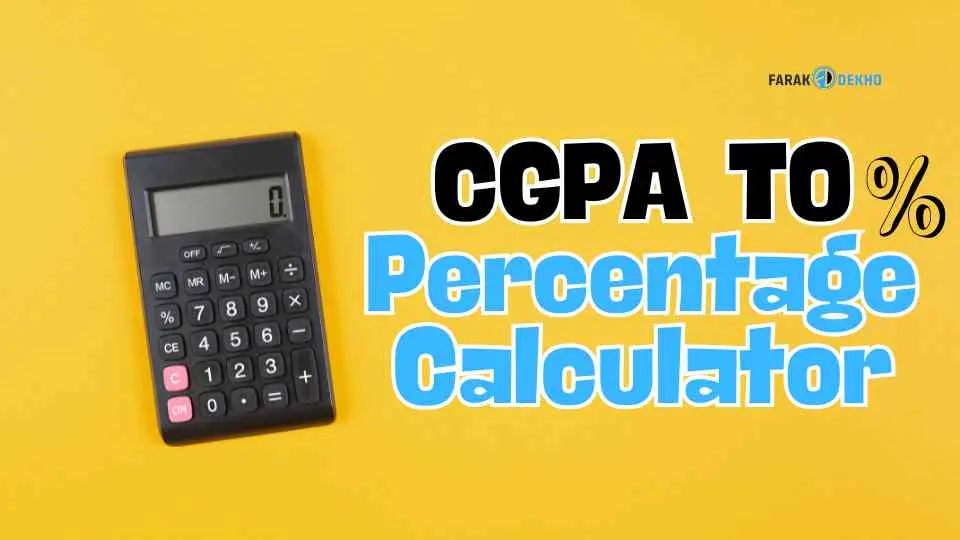This comprehensive guide explains the CGPA to Percentage Conversion Calculator, detailing how to convert CGPA scores to percentages for different grading systems and providing insights into the benefits and nuances of both metrics. It is a valuable resource for students, educational institutions, and employers seeking to effectively understand and utilize these academic performance measures.
CGPA TO PERCENTAGE CALCULATOR
Grade Conversion Calculator
Introduction to CGPA and Percentage
The Cumulative Grade Point Average (CGPA) and percentage are two widely used measures of academic performance in educational institutions. CGPA is a numerical representation of a student’s overall academic performance, while the percentage is a more traditional way of expressing academic achievement. Understanding the relationship between CGPA and percentage is crucial for students, educational institutions, and employers.
Understanding CGPA: Calculation and Conversion
How to Compute CGPA from Grade Points
CGPA is calculated by dividing the total grade points earned by the total credits attempted. The grade points are awarded based on the grades received in individual courses, and the credits are assigned based on the course’s weightage or importance.
Converting CGPA to Percentage
Converting CGPA to percentage is a straightforward process that involves multiplying the CGPA by a conversion factor. The conversion factor may vary depending on the grading system used by the educational institution.
Conversion Factors for Different Grading Systems
Educational institutions may use different grading systems, such as the 4-point scale, 10-point scale, or letter grades. The grading system and the maximum possible CGPA determine the conversion factor.
Examples of CGPA to Percentage Conversion
To illustrate the conversion process, consider the following examples:
| CGPA | Percentage (4-point) | Percentage (10-point) |
|---|---|---|
| 1.0 | 25% | 10% |
| 1.5 | 37.5% | 15% |
| 2.0 | 50% | 20% |
| 2.5 | 62.5% | 25% |
| 3.0 | 75% | 30% |
| 3.5 | 87.5% | 35% |
| 4.0 | 100% | 40% |
| 5.0 | 50% | |
| 6.0 | 60% | |
| 7.0 | 70% | |
| 8.0 | 80% | |
| 8.2 | 82% | |
| 9.0 | 90% | |
| 10.0 | 100% |
Benefits of CGPA and Percentage Conversion
Benefits of CGPA
CGPA provides a comprehensive and standardized measure of a student’s academic performance across multiple courses and semesters. It helps compare students’ achievements within the same educational institution and facilitates the evaluation of academic records.
Benefits of Percentage
Percentage is a widely recognized and understood metric useful for students applying for higher education or employment opportunities. It provides a more intuitive representation of academic performance and allows for easier comparison across different grading systems or educational institutions.
Grading Systems in Educational Institutions
Common Grading Systems
Sure, here’s a comparison table of different grading systems commonly used in educational institutions, along with their corresponding CGPA (Cumulative Grade Point Average) and percentage calculation methods:
| Grading System | Grade Scale | CGPA Calculation | Percentage Calculation |
|---|---|---|---|
| 4-point scale | A=4, B=3, C=2, D=1, F=0 | CGPA = (Total Grade Points / Total Credits) | Percentage = (CGPA – 0.5) * 10 |
| 10-point scale | 10-7=Excellent, 6=Good, 5=Average, 4=Pass, <4=Fail | CGPA = (Total Grade Points / Total Credits) | Percentage = (CGPA / 4) * 100 |
| Letter grades | A, B, C, D, F | CGPA = (Total Grade Points / Total Credits) | Percentage calculation varies based on institution’s conversion scale |
Differences Between CGPA and GPA
- CGPA (Cumulative Grade Point Average):
- Represents the overall academic performance throughout a student’s educational journey.
- Considers all completed courses and semesters.
- Offers a comprehensive view of the student’s overall achievement.
- Used for evaluating eligibility for honors, scholarships, admission to higher education institutions, and employment screening purposes.
- GPA (Grade Point Average):
- Calculated for a specific period, such as a semester or academic year.
- Focuses on grades achieved within a defined timeframe.
- Provides a snapshot of a student’s performance within that particular period.
- Used by educational institutions to assess progress and performance in individual terms or programs, monitor academic standing, and make decisions regarding academic probation, honors, or awards for a specific period.
Converting CGPA to GPA
How to Convert a 10-Point CGPA to a 4-Point GPA
| CGPA (10-point scale) | GPA (4-point scale) |
|---|---|
| 10.0 | 4.0 |
| 9.5 | 4.0 |
| 9.0 | 3.8 |
| 8.5 | 3.6 |
| 8.0 | 3.4 |
| 7.5 | 3.2 |
| 7.0 | 3.0 |
| 6.5 | 2.8 |
| 6.0 | 2.6 |
| 5.5 | 2.4 |
| 5.0 | 2.2 |
| 4.5 | 2.0 |
Note that for CGPA values below 4.5, the conversion results in a GPA below 2.0, which may not be applicable or desirable in some cases.
Steps for CGPA to GPA Conversion
Here are the steps to convert CGPA to GPA:
- 1) Identify the grading system used by the institution.
- 2) Apply the appropriate conversion formula based on the grading system.
- 3) Round the result to two decimal places.
Improving CGPA: Tips and Strategies
Maintaining a good CGPA is essential for academic success and prospects. Some tips and strategies for improving CGPA include:
- 1) Consistent study habits and time management
- 2) Seeking help from professors or tutors when needed
- 3) Participating actively in class and completing assignments on time
- 4) Develop effective note-taking and exam-preparation techniques
Disadvantages of Using CGPA
While CGPA is a widely accepted measure of academic performance, it has some disadvantages:
- 1) It may need to accurately reflect the difficulty level of courses or the distribution of grades within a class.
- 2) Different grading systems and calculation methods can make it challenging to compare CGPA across institutions.
- 3) CGPA does not consider factors like extracurricular activities, leadership roles, or professional experiences.
Cheapest Online BCA Colleges in India (2025): A Complete Guide
For students looking for a low-cost and UGC-approved online BCA degree, top choices in India include Hindustan Online, Amity University…
Amity University Online vs. Manipal: Which One Is Better for
Choosing the right online university is a critical decision that can impact your career and future success. With so many…
UGC vs AICTE: Complete Guide to Indian Higher Education Regulatory
What is the difference between UGC and AICTE?UGC (University Grants Commission) regulates and recognizes universities in India, while AICTE (All…
Can Commerce Students Do BCA After 12th? A Comprehensive Guide
The field of information technology (IT) is growing rapidly, offering new career opportunities for students from all academic backgrounds. While…
Online MBA in Pharmaceutical Management: Complete Guide 2025
What is an online MBA in pharmaceutical management?An online MBA in pharmaceutical management is a postgraduate program tailored for individuals…
Is NMIMS Online MBA UGC Approved? Full Details on Approval
NMIMS Online MBA programs are fully UGC-DEB approved for 2024-2025. After resolving compliance issues in 2023, the university regained complete…
Frequently Asked Questions (FAQs)
CGPA is a numerical representation of a student’s overall academic performance, while the percentage is a more traditional way of expressing academic achievement. CGPA is calculated based on grade points and credits, while percentage is derived from converting CGPA using a conversion factor.
The grading system used by an educational institution determines the calculation method and conversion factors for CGPA and percentage. Different grading systems, such as the 4-point scale, 10-point scale, or letter grades, require different conversion formulas.
Both CGPA and percentage are essential for admission and job applications. However, some institutions or employers may prefer one over the other. It is necessary to understand the requirements of the specific institution or employer and present the appropriate measure of academic performance.
Additional Resources and Tools
- 1) Online CGPA to Percentage Calculators
- 2) Educational institution websites for grading policies and conversion factors
- 3) Career counselling services for guidance on academic performance and applications
Disclaimer and Terms of Use
The information provided in this article is for educational and informational purposes only. It should be considered as something other than professional advice or a substitute for consulting with academic institutions or relevant authorities. The accuracy and completeness of the information cannot be guaranteed, and Farakdeeho shall not be held responsible for any errors, omissions, or consequences arising from the use of this information.

Lovepreet Sachdeva is an SEO Specialist with extensive experience in helping businesses improve their online presence. He is dedicated to providing top-notch SEO services and personalized strategies to boost your website’s performance. Contact him today for professional SEO assistance.








